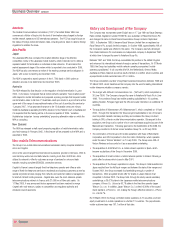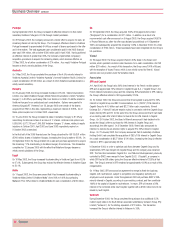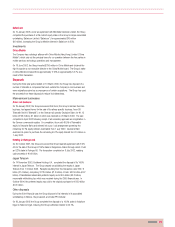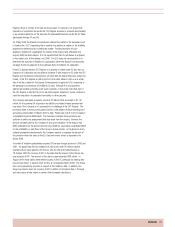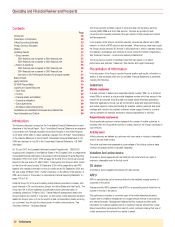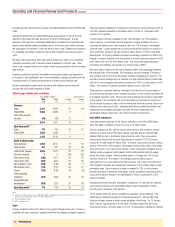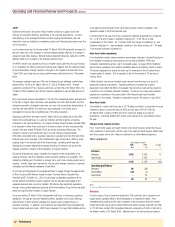Vodafone 2005 Annual Report Download - page 32
Download and view the complete annual report
Please find page 32 of the 2005 Vodafone annual report below. You can navigate through the pages in the report by either clicking on the pages listed below, or by using the keyword search tool below to find specific information within the annual report.
Operating and Financial Review and Prospects continued
30 |Performance
Goodwill, including associated charges for amortisation, affects all of the Group’s
reported segments. However, given that the majority of the current goodwill asset
arose in connection with the Mannesmann acquisition, the Group’s results for Germany
and Italy are most affected, individually representing £6,824 million and £3,779
million, respectively, of the £14,700 million total charge for goodwill amortisation.
US GAAP
Under US GAAP, the accounting treatment for goodwill and other intangible assets is
different to that required by UK GAAP and represents the most significant adjustment
made to the Group’s results and financial position under UK GAAP when reconciling to
US GAAP. For acquisitions prior to 29 September 2004, the key difference from UK
GAAP is that for the acquisition of mobile network businesses, the residual purchase
price is allocated to the licences, as opposed to goodwill under UK GAAP. However,
subsequent to this date and due to the SEC prohibition of this residual method of
accounting, licences will be valued using a direct valuation approach, with the residual
being allocated to goodwill. For other acquisitions, the residual has been and will
continue to be allocated to goodwill.
Other principal differences are:
a) The allocation of the surplus of the residual purchase price, over the fair value
attributed to the share of net tangible assets acquired, to identifiable intangible
assets including licences in addition to goodwill under US GAAP as opposed to only
goodwill under UK GAAP;
b) The US GAAP deferred tax treatment of intangible assets, which increases
acquisition liabilities and consequently the residual purchase price; and
c) The difference in goodwill arising as a result of the different basis by which the
purchase price is derived under US GAAP.
Of these adjustments, the only one to involve significant management judgement and
estimation is the allocation of the purchase price. Allocation of the purchase price
affects the future results of the Group under US GAAP, as finite-lived intangible assets
are amortised whereas indefinite-lived intangible assets are not amortised, and could
result in differing amortisation charges based on the allocation to goodwill, indefinite-
lived intangible assets and finite-lived intangible assets.
Bases of amortisation
Goodwill
Once capitalised, goodwill is amortised on a straight line basis over its estimated useful
economic life.
Other intangible assets
Other intangible assets primarily represent the Group’s aggregate amounts spent on
the acquisition of 2G and 3G licences, stated after deduction of related amortisation
charges.
Since revenue cannot be generated until a network is available for commercial service,
amortisation of capitalised licences begins at this time. As networks are typically
brought into service over a period of time, the charge for amortisation is initially
calculated by reference to the capacity of the network compared to capacity at network
maturity. For this purpose, network maturity is determined as being reached after a
maximum period of five years from service launch. Thereafter, amortisation is on a
straight line basis over its remaining useful economic life. Management considers this
policy is the appropriate method of matching the amortisation with the economic
benefit derived from the licences.
If the licences were amortised over their economic life on a straight line basis, the
annual amortisation charge would be higher in the period to network maturity and
lower thereafter.
US GAAP
Goodwill and other indefinite-lived intangible assets are not amortised but reviewed
annually for impairment. Impairment reviews are discussed in more detail below. The
majority of the Group’s intangible assets, primarily 2G and 3G licences, are finite-lived
and are amortised over their estimated economic life on a straight line basis, which
commences when the network is available for commercial service.
Estimation of useful economic life
The economic life used to amortise goodwill and other intangible fixed assets relates to
the future performance of the assets acquired and management’s judgement of the
period over which economic benefit will be derived from the asset.
Goodwill
For acquired mobile network operators, the useful economic life of goodwill reflects the
useful economic life of the licences acquired with those businesses up to a maximum
of twenty-five years. In management’s view, such businesses cannot operate in their
respective jurisdiction without a licence, and so the licence term is the most
appropriate life for the goodwill. The useful economic lives are reviewed annually and
revised if necessary.
For other businesses acquired, the useful economic life principally reflects
management’s view of the average economic life of the acquired customer base. The
useful economic life is assessed by reference to customer churn rates. An increase in
churn rates may lead to a reduction in the useful economic life and an increase in the
amortisation expense. Historically, changes in churn rates have been insufficient to
impact the useful economic life.
Other intangible assets
For licence and spectrum fees, the estimated useful economic life is, generally, the
term of the licence, unless there is a presumption of renewal. Using the licence term
reflects the period over which the Group will receive economic benefit. For technology
specific licences with a presumption of renewal, the estimated useful economic life
reflects the Group’s expectation of the period over which the Group will continue to
receive economic benefit from the licence. The economic lives are periodically
reviewed, taking into consideration such factors as changes in technology. Historically,
any changes to economic lives have not been material following these reviews.
Tangible fixed assets
Tangible fixed assets also represent a significant proportion of the asset base of the
Group and hence the estimates and assumptions made to determine their carrying
value and related depreciation are critical to the Group’s financial position and
performance.
Estimation of useful economic life
The charge in respect of periodic depreciation is derived after determining an estimate
of an asset’s expected useful life and the expected residual value at the end of its life.
Increasing an asset’s expected life or its residual value would result in a reduced
depreciation charge in the Group’s profit and loss account.
The useful economic lives of Group assets are determined by management at the time
the asset is acquired and regularly reviewed for appropriateness. The lives are based
on historical experience with similar assets as well as anticipation of future events,
which may impact their life, such as changes in technology. Furthermore, network
infrastructure cannot be depreciated over a period that extends beyond the expiry of
the associated licence under which the operator provides telecommunications services.
Historically, changes in useful economic lives have not resulted in material changes to
the Group’s depreciation charge.


